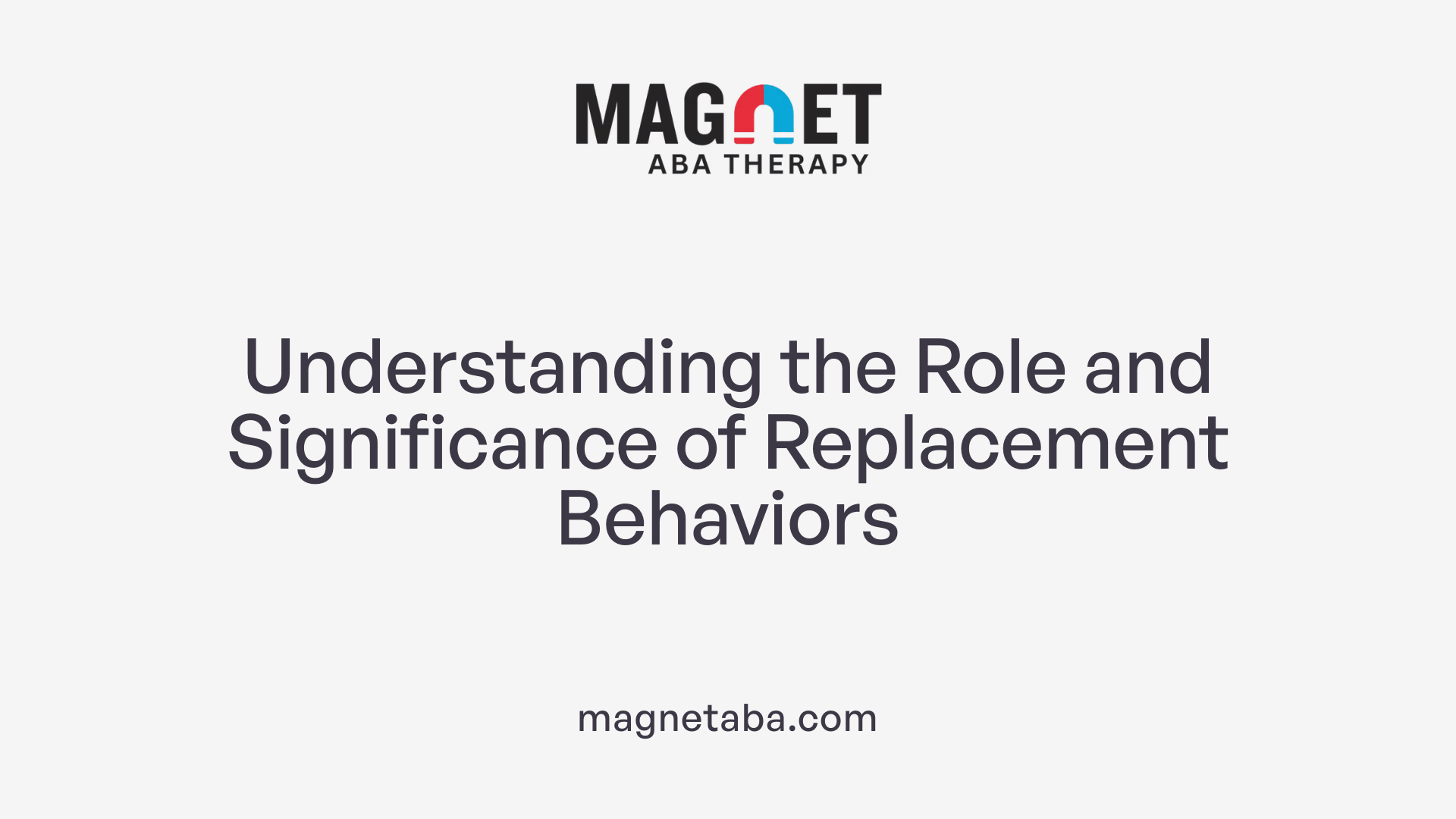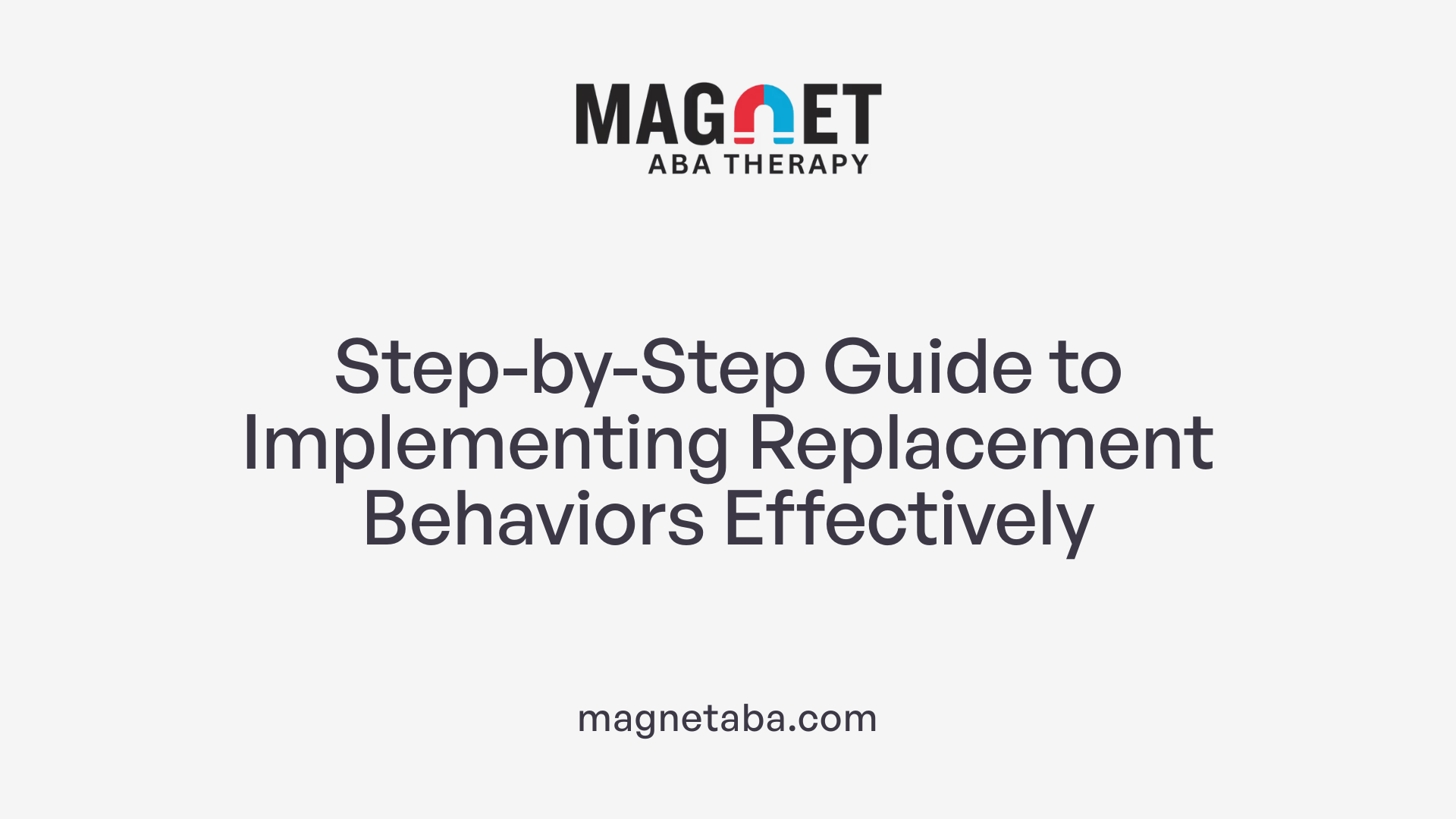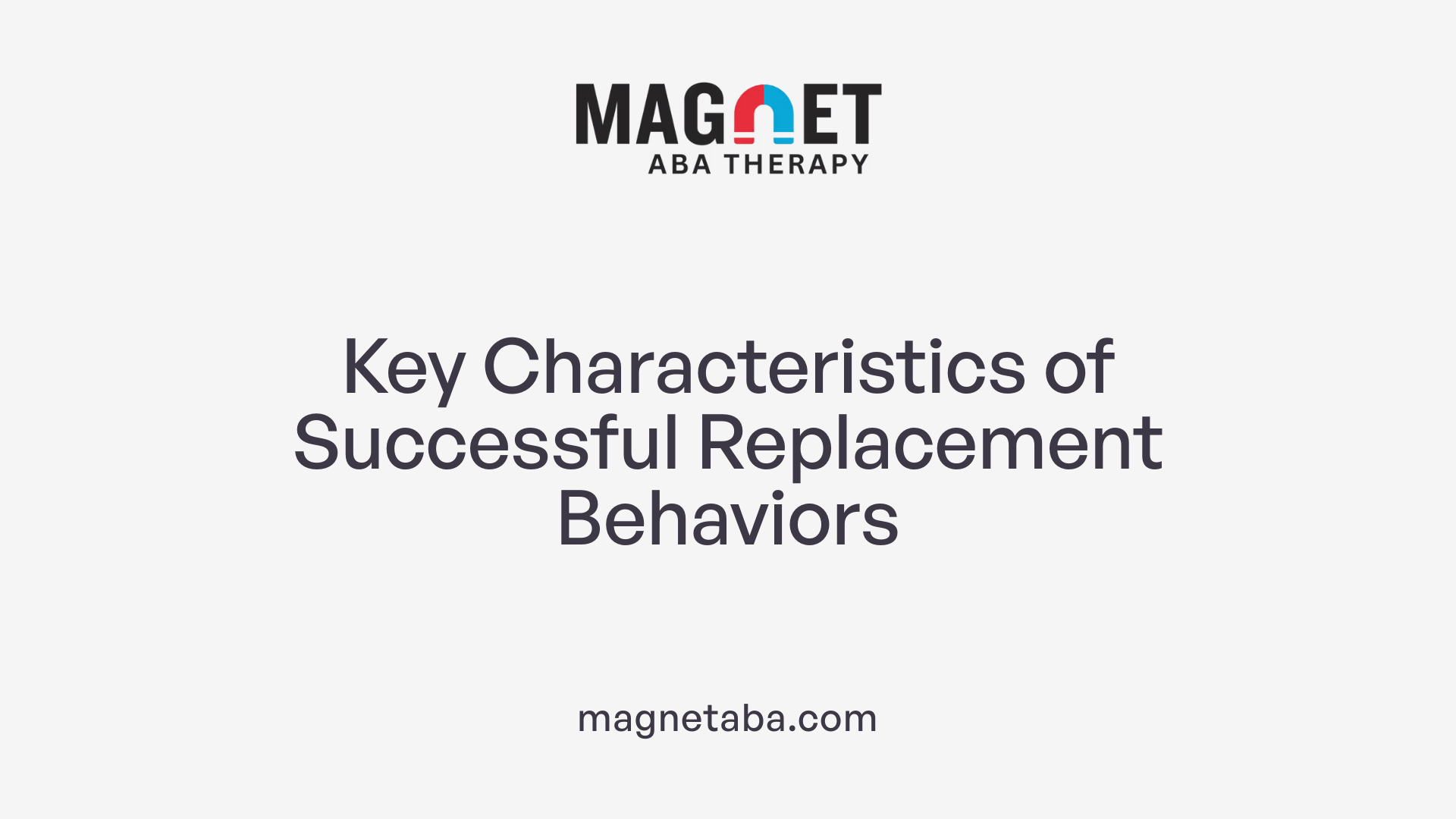Understanding Replacement Behaviors: Foundations and Significance
Replacement behaviors are structured, positive actions taught to individuals to substitute for problematic behaviors. They play a critical role in behavior management by addressing the underlying functions that drive challenging actions, such as seeking attention, escaping a task, or fulfilling sensory needs. Recognizing what replacement behaviors are and why they matter is key to developing effective intervention strategies that foster long-term positive change and personal growth.
Defining Replacement Behaviors and Their Importance

What are replacement behaviors and why do they matter?
Replacement behaviors are positive and socially acceptable actions that are intentionally taught to children or individuals to substitute for challenging or undesirable behaviors. These behaviors serve the same function as the problematic behaviors, meaning they help meet the same needs or goals, such as gaining attention, escaping an uncomfortable situation, or seeking sensory stimulation.
Teaching replacement behaviors is crucial because it allows individuals to express their needs or regulate their emotions in a more appropriate way. For example, a child who hits to get attention can be taught to raise their hand or use words instead. Similarly, a person who screams to escape work can learn to ask for a break calmly.
The importance of replacement behaviors lies in their ability to facilitate lasting behavior change. Instead of merely suppressing bad behaviors, we encourage positive alternatives that fulfill the same purpose, leading to more effective and sustainable improvements.
Addressing the function of the behavior—that is, why the behavior occurs—is fundamental. Once the function is understood, educators and clinicians select strategies that are practical, easier to perform, and more socially acceptable. Consistent reinforcement of these behaviors ensures that the individual learns to use them in relevant situations.
Overall, replacement behaviors play a vital role in behavioral interventions by helping individuals develop better social skills, improve communication, and manage impulses, thereby enhancing their overall quality of life.
Why are individuals taught to use replacement behaviors?
Individuals are taught replacement behaviors to provide them with effective tools to deal with situations that typically provoke challenging behaviors. When a person learns to replace an undesirable behavior with a positive alternative, they can better meet their needs in socially appropriate ways.
For instance, a student who cries when frustrated can be taught to use a calm voice or communicate their feelings with words. An individual who acts out to escape tasks can learn to ask for a break instead.
Teaching these skills is based on understanding the behaviors' functions, such as attention, escape, sensory pleasure, or access to tangible items. Once the function is identified, educators and therapists select replacement actions that serve the same purpose but are more acceptable to society and less disruptive.
Consistent practice and reinforcement are essential. When individuals receive immediate feedback and positive reinforcement for using replacement behaviors, they are more likely to adopt them consistently.
This approach often results in reduced frequency of problematic behaviors and promotes independence, self-control, and better communication abilities. Such improvements contribute to more positive interactions with caregivers, peers, and teachers, ultimately supporting the individual's long-term development and well-being.
Implementing Replacement Behaviors: A Step-by-Step Approach

How can replacement behaviors reduce problematic behaviors?
Replacement behaviors serve as positive, functional alternatives to undesired behaviors. They are designed to fulfill the same purpose, such as gaining attention, escaping an unpleasant task, or seeking sensory stimulation. When a replacement behavior is taught and reinforced, it decreases the likelihood of the problematic behavior occurring because it satisfies the same need more appropriately.
Teaching these skills involves careful analysis of the function behind the original behavior. Once the function is understood—whether attention-seeking, escape, access to objects, or sensory needs—appropriate replacement behaviors are chosen that meet those same needs.
Consistent reinforcement plays a crucial role in establishing new behaviors. Adults and educators provide immediate, meaningful reinforcement when the individual uses the replacement behavior correctly. This reinforcement encourages repetition and helps established the new skill.
Modeling, practice, and gradual exposure in familiar settings promote the ease of adoption. Over time, with ongoing reinforcement and fewer consequences for problem behaviors, these replacement behaviors become more frequent and natural, leading to an overall reduction in problematic behaviors.
By addressing the underlying function of the behavior and replacing it with a suitable alternative, individuals are empowered with more effective and socially acceptable strategies to meet their needs. This process not only reduces problematic actions but also boosts confidence and independence.
What strategies are most effective for teaching replacement behaviors?
Effective instruction begins with assessing and understanding the specific function of challenging behaviors. Once identified, a suitable replacement behavior—one that serves the same purpose and is developmentally appropriate—is selected.
Teaching the replacement behavior involves explicit instruction with modeling and rehearsal. Visual supports, cue cards, and simple scripts can serve as helpful reminders that typical learners find beneficial. The teaching environment should be calm and predictable, allowing the learner to practice without stress.
Gradual prompts and structured opportunities for independent practice help solidify the new behavior. Reinforcement is critical: immediately rewarding the proper use of the replacement behavior with meaningful motivators—such as praise, preferred activities, or tangible reinforcers—encourages continued use.
Monitoring progress helps identify if the replacement behavior is becoming habitual. Adjustments to teaching methods or reinforcement strategies may be necessary if progress slows or plateaus.
Consistent application of these strategies using a behavioral support plan ensures that replacement behaviors are adopted effectively, ultimately leading to sustainable behavioral change.
Characteristics of Effective Replacement Behaviors

What are the characteristics of effective replacement behaviors?
Effective replacement behaviors are actions children can perform that are observable, measurable, and clearly defined. These behaviors should serve the same purpose or function as the problematic behavior they aim to replace. For example, if a child screams to gain attention, a replacement behavior might be raising their hand politely.
It is important that replacement behaviors are socially valued and culturally acceptable, ensuring they fit within different environments such as school, home, and community settings.
A hallmark of these behaviors is that they provide a better payoff than the challenging ones. This means they are easier, faster, or more reliable in obtaining the same reinforcer such as attention, escape, or sensory stimulation.
Teaching these behaviors involves breaking down skills into manageable steps, practicing them repeatedly, and reinforcing progress consistently. This structured approach helps children learn what to do instead of engaging in problematic behaviors.
Choosing the right replacement behavior depends on understanding the function of the challenging behavior. If the behavior is driven by a need for attention, teaching a child to say “excuse me” or to tap a teacher’s hand can be effective. If it’s to escape a task, requesting a break can serve as an appropriate alternative.
Importantly, reinforcement plays a vital role. Replacement behaviors should be reinforced immediately and consistently until they become habitual. Over time, reinforcement can be faded, but the behaviors should still be maintained through continued, meaningful reinforcement.
In summary, effective replacement behaviors are observable, serve the same function, are developmentally appropriate and easy to perform, provide better payoffs, and are reinforced consistently. When these characteristics are met, the likelihood of reducing problematic behaviors significantly increases, leading to more positive and functional interactions.
Applications and Examples of Replacement Behaviors in Various Contexts

Can you provide examples of replacement behaviors in various contexts?
Replacement behaviors are tailored to fit different environments and are chosen based on the function of the challenging behavior. They are socially acceptable actions that serve the same purpose as the problematic behavior.
In educational settings, for instance, a student who throws objects to avoid tasks might be taught to request a break or use a calm signal. A child who pushes peers to seek attention could learn to tap a friend on the shoulder or raise their hand.
Similarly, if a child cries to gain access to tangible items, they might be taught to ask verbally or gesture appropriately for what they want.
These replacements are observable and measurable, ensuring they can be consistently taught and reinforced.
The primary goal is to help the individual meet their needs in a prosocial way, leading to more positive interactions and reducing problematic behaviors.
What strategies support the implementation of replacement behaviors in support plans?
Successful implementation begins with understanding the purpose of the challenging behavior through functional assessment.
Once the function is identified, specific replacement behaviors that serve the same purpose are selected. These behaviors are then systematically taught using strategies like modeling, guided practice, and positive reinforcement.
Visual supports, such as cue cards or social stories, are effective tools to help students understand and remember new behaviors.
Consistent reinforcement—offering immediate and meaningful rewards—encourages mastery.
Involving students in choosing their replacement behaviors can increase motivation and appropriateness.
Moreover, proactive planning, including precorrections and teaching self-calming techniques, supports long-term success.
Implementing these strategies within a multi-tiered support system helps ensure the behaviors generalize across settings and situations.
Examples in Educational Settings
| Challenging Behavior | Replacement Behavior | Function Served | Supports Used | Example |
|---|---|---|---|---|
| Throwing objects | Requesting a break | Escape from task | Visual cues, modeling | Student asks for a break instead of throwing objects. |
| Pushing peers | Tapping or greeting | Gaining attention | Scripts, visual cues | Student taps hand gently or says hello instead of pushing. |
| Crying for items | Verbally asking | Access to tangible | Reinforcement, practice | Child asks for a toy politely instead of crying. |
Context-Specific Replacement Behaviors
Different settings require tailored approaches. For example, in a classroom, teaching a child to raise their hand or use a communication device works well.
In recess or outdoor activities, teaching safe running or using sensory tools like water or fidget toys addresses sensory-seeking behaviors.
In therapy environments, visual timers help children understand the concept of waiting, reducing frustration and disruptive behaviors.
Functional Communication and Sensory Strategies
Functional Communication Training (FCT) is a popular way to teach children to communicate their needs effectively.
Sensory-based replacement behaviors involve activities like sensory bins, lotion, or water play, which can satisfy sensory needs without causing disruption.
These strategies are essential when behaviors are driven by sensory stimulation, especially if automatic reinforcement is involved.
Use of Visuals, Cues, and Scripts
Visual aids are valuable in teaching replacement behaviors. Cue cards, visual timers, and simple scripts help children understand what is expected.
For instance, a visual cue might remind a student to raise their hand instead of shouting.
Scripts can guide responses, making the new behaviors clearer and more consistent.
The combination of visuals, cues, and practice supports acquisition and generalization of replacement skills.
| Implementation Tools | Purpose | Example | Benefits |
|---|---|---|---|
| Visual timers | Teach waiting and patience | Waiting for turn in line | Reduces frustration |
| Cue cards | Remind about replacement behaviors | Asking politely for help | Increases independence |
| Scripts and social stories | Practice specific responses | Greeting peers appropriately | Builds confidence |
In summary, effective replacement behaviors are specific, functionally matched, and supported by consistent teaching tools. They promote long-term, positive behavioral changes and improve individual functioning across various environments and functions.
The Role of Replacement Behaviors in Special Education and PBIS

What is the role of replacement behaviors in autism and special education?
Replacement behaviors serve a vital function in autism and special education by offering positive alternatives to challenging behaviors. These behaviors help learners meet the same needs as problematic actions but in a more suitable way. For example, a child who screams to gain attention can be taught to raise their hand or use a communication device instead.
Teaching effective replacement behaviors involves understanding what the individual is trying to achieve through their behavior. Once the function is identified—such as seeking attention, escaping a task, or fulfilling sensory needs—interventions focus on teaching skills that serve the same purpose. These skills should be developmentally appropriate, simple to perform, and as or more effective than the problematic behavior.
A systematic approach includes explicitly teaching these behaviors through modeling, guided practice, and reinforcement. Reinforcements are provided immediately and are aligned with the learner’s preferences to motivate their use. Monitoring progress ensures that the replacement behaviors are retained and generalized across settings. Overall, integrating replacement behaviors supports behavioral improvement, enhances communication, and fosters independence for individuals with special needs.
How are replacement behaviors integrated into PBIS frameworks?
In the context of Positive Behavioral Interventions and Supports (PBIS), replacement behaviors are embedded within a structured, data-driven process geared towards reducing problematic actions. The first step involves conducting a Functional Behavioral Assessment (FBA) to determine the reason behind the challenging behavior.
Based on the identified function, educators develop Behavior Intervention Plans (BIPs) that include teaching a socially acceptable, functionally equivalent replacement behavior. These replacement actions are clear, observable, and culturally appropriate, increasing their likelihood of adoption and success.
In practice, replacement behaviors are explicitly taught using visual cues, scripts, or social stories, making them easy for students to understand and remember. The use of positive reinforcement—such as praise, tokens, or preferred activities—encourages students to use the replacement behaviors consistently.
The goal is to help students access reinforcement through positive means, which are often more rewarding than problematic behaviors. By systematically teaching and reinforcing replacement behaviors, PBIS creates proactive support systems. This approach fosters a positive school climate, reduces the incidence of disruptive behaviors, and promotes sustainable behavioral change across all levels of intervention.
| Aspect | Implementation Strategy | Purpose | Example |
|---|---|---|---|
| Identification | Conduct FBA to find the function | Understand the 'why' behind behavior | Attention-seeking, escape, sensory needs |
| Teaching | Model, prompt, and practice replacement behaviors | Provide clear, observable alternatives | Asking for a break instead of acting out |
| Reinforcement | Immediate, meaningful rewards | Increase likelihood of use | Verbal praise for using words |
| Monitoring | Data collection and review | Track progress | Recording frequency of replacement behavior |
| Generalization | Practice in different settings | Ensure enduring skills | Using the replacement at home and school |
In conclusion, incorporating replacement behaviors within PBIS allows educators to address challenging behaviors proactively. By focusing on teaching meaningful alternatives, schools can promote healthy social development, improve safety, and support learners in achieving their full potential.
Fostering Sustainable Behavioral Change
Implementing replacement behaviors involves a systematic process that combines understanding the function of challenging behaviors, selecting appropriate alternatives, and reinforcing them effectively. By focusing on teaching socially acceptable, functional, and developmentally suitable alternatives, educators and caregivers can significantly reduce problematic behaviors and promote positive, adaptive skills. Integration into frameworks like PBIS and structured support plans ensures consistent application and generalization across settings. Ultimately, teaching replacement behaviors not only diminishes problematic actions but also enhances individuals’ independence, communication, and overall quality of life, supporting a more inclusive and respectful environment for all.
References
- Empowering Students with Replacement Behaviors - How to ABA
- Replacement Behaviors
- What Are Replacement Behaviors and What Do We Need To Know ...
- Why You NEED a Replacement Behavior - The Autism Helper
- How to change challenging behaviors: Replacement ... - Alpha School
- Teaching Replacement Behaviors in a BIP: Practical Guide
- Increase Student Learning by Teaching Replacement Behaviors - n2y












